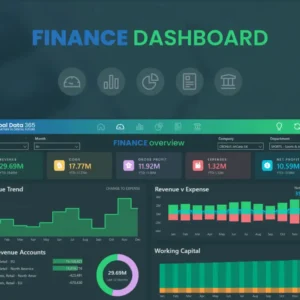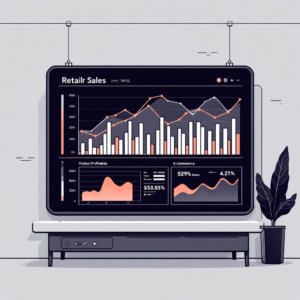Introduction
In today’s fast-paced business environment, data is recognized as a valuable asset, with organizations increasingly relying on data-driven insights to make strategic decisions. At the heart of this data revolution is the concept of ‘big data’, referring to large volumes of structured, unstructured, and semi-structured data that can be analyzed to uncover valuable patterns and trends.
Microsoft Power BI is a leading data visualization and business intelligence platform that empowers organizations to extract actionable insights from their data. With its robust capabilities, Power BI can handle large datasets, providing a comprehensive view of business operations and enabling data-driven decision-making.
In this article, we will delve into the world of Power BI and big data, exploring how Power BI can efficiently manage and analyze large datasets, the crucial role of data modeling in this process, and the significant impact it can have on business insights and strategy. By the end, you should have a comprehensive understanding of how Power BI can be harnessed to unlock the power of your organization’s data.
Understanding Big Data and Its Challenges
Big data is characterized by the 5 Vs: volume, velocity, variety, veracity, and value.
Volume refers to the sheer amount of data generated, which can be massive, often exceeding the capacity of traditional data processing tools.
Velocity pertains to the speed at which data is generated and the need for real-time or near-real-time processing.
Variety describes the diverse types of data, including structured, unstructured, and semi-structured data, such as text, images, videos, and sensor data.
Veracity relates to the quality and consistency of the data, which can vary widely, affecting the accuracy of insights.
Finally, value represents the potential insights and business benefits derived from analyzing big data effectively.
One of the main challenges of big data is the ability to process and analyze it efficiently, extracting meaningful information. Traditional data processing techniques often fall short, leading to the need for specialized tools and skills. Power BI, with its advanced capabilities, steps in to address these challenges.
Power BI: A Powerful Tool for Big Data Analytics
Power BI is a versatile and robust platform that offers a range of features to handle big data effectively. Here’s how Power BI can be leveraged to overcome the challenges posed by large datasets:
Data Connectivity and Ingestion: Power BI provides a wide range of data connectors, allowing users to connect to various data sources seamlessly. Whether it’s pulling data from databases, data lakes, cloud services, or even the web, Power BI simplifies the process of bringing data together. For big data, Power BI can connect directly to data stored in Azure Data Lake Storage or Azure HDInsight, Microsoft’s distributed storage and processing systems for big data.
Data Transformation and Preparation: Once the data is ingested, Power BI provides a range of data transformation and preparation tools. Power Query, for example, allows users to clean, transform, and reshape data with ease. With Power Query, complex transformations can be applied to large datasets, preparing the data for meaningful analysis.
Data Modeling: Effective data modeling is crucial when working with big data. Power BI’s data modeling capabilities enable users to create relationships between tables, define calculations, and build a semantic layer that simplifies complex data structures. By creating a well-designed data model, users can navigate large datasets efficiently and derive meaningful insights.
Scalable Visualizations: Power BI offers a rich set of visualizations that are designed to handle large datasets. From treemaps and heatmaps to scatter charts and custom visuals, Power BI visualizations are optimized to render large amounts of data effectively. Users can explore and interact with the data, drilling down into specific areas of interest without sacrificing performance.
Quick Insights: Power BI’s Quick Insights feature uses machine learning algorithms to automatically uncover patterns and trends in large datasets. With a single click, users can gain valuable insights, identify correlations, and make informed decisions based on intelligent data analysis.
Natural Language Queries: Power BI’s natural language processing capabilities allow users to ask questions about their data in natural language. This intuitive interface empowers users to explore big data without the need for complex queries, making data analysis accessible to a wider audience.
Case Study: Retail Industry
Let’s consider a real-world example of how Power BI can be applied to big data in the retail industry.
A large retail chain aims to enhance its customer experience and optimize inventory management across hundreds of stores. The company collects and analyzes large volumes of data, including sales transactions, customer demographics, social media interactions, and sensor data from in-store cameras and shelves.
By leveraging Power BI, the retailer can:
Connect to various data sources and ingest data in near-real-time, ensuring up-to-date insights.
Transform and prepare the data, creating a unified view of customers across multiple touchpoints.
Build a data model that links sales, customer, and product data, enabling a 360-degree view of store performance.
Visualize large datasets on interactive dashboards, allowing regional managers to monitor sales performance, identify trends, and compare stores.
Utilize Quick Insights to uncover patterns, such as correlations between promotional campaigns and sales spikes, or customer demographics and purchasing behavior.
Use natural language queries to ask questions like “Which stores had the highest sales growth last quarter?” and receive instant answers.
With Power BI, the retailer can make data-driven decisions, optimize inventory levels, enhance customer satisfaction, and ultimately improve its bottom line.
The Impact of Power BI on Business Insights
The ability to handle big data with Power BI has a profound impact on business insights and decision-making. Here are some key ways in which Power BI transforms businesses:
Enhanced Data Exploration: Power BI enables organizations to explore large datasets interactively, uncovering insights that may have been previously hidden. With its advanced filtering, slicing, and drilling capabilities, users can delve into specific areas of interest, identifying trends and patterns that drive strategic decisions.
Improved Data-Driven Culture: By making big data accessible and understandable, Power BI fosters a data-driven culture within organizations. Employees at all levels can explore and analyze data, leading to more informed decision-making across the board. This shift empowers teams to take ownership of their data and contribute to the organization’s success.
Real-Time Insights: Power BI’s ability to handle streaming data and provide real-time insights is a game-changer for businesses. From monitoring live sales data to tracking customer behavior on websites, real-time insights enable businesses to react swiftly to market changes, optimize operations, and gain a competitive edge.
Predictive Analytics: Power BI, integrated with Azure Machine Learning, enables organizations to go beyond descriptive analytics and venture into predictive analytics. By applying machine learning algorithms to big data, businesses can forecast trends, anticipate customer behavior, and make proactive decisions, staying ahead of the curve.
Actionable Business Intelligence: Ultimately, Power BI transforms raw data into actionable business intelligence. The insights derived from big data analysis can drive strategic initiatives, product innovations, marketing campaigns, and operational efficiencies. Power BI empowers organizations to turn data into a competitive advantage, improving financial performance and market position.
Best Practices for Handling Big Data in Power BI
When working with big data in Power BI, there are several best practices to ensure optimal performance and effective insights:
Optimize Data Model: Design an efficient data model by properly relating tables, using star or snowflake schemas, and minimizing complex calculations. This ensures faster query performance and easier navigation for users.
Leverage Aggregations: Create aggregated tables or use composite models to summarize large datasets, improving query performance. Aggregations can be particularly useful for historical data or when drilling down into specific dimensions.
Use DirectQuery Wisely: While DirectQuery can be useful for large datasets, it may impact performance. Consider the trade-offs and ensure proper indexing and query optimization when using this approach.
Implement Data Security: With big data, data security becomes even more critical. Utilize Power BI’s row-level security and data protection features to ensure that only authorized users can access sensitive data.
Test Performance: Regularly test the performance of your Power BI reports, especially when working with big data. Identify potential bottlenecks and optimize your data model and visualizations accordingly.
Conclusion
In conclusion, Power BI and big data are a dynamic duo, empowering organizations to unlock valuable insights from large datasets. With its robust data handling capabilities, intuitive data modeling, and interactive visualizations, Power BI transforms complex data into actionable business intelligence.
As we’ve explored, the impact of effectively harnessing big data with Power BI is significant, leading to enhanced data exploration, a more data-driven culture, real-time insights, and predictive analytics.
By following best practices and leveraging Power BI’s advanced features, organizations can make data-driven decisions with confidence, improving their competitive advantage.
So, how are you utilizing Power BI to harness the power of big data? What insights have you unlocked, and what impact has it had on your business? Let’s continue the conversation in the comments below!






